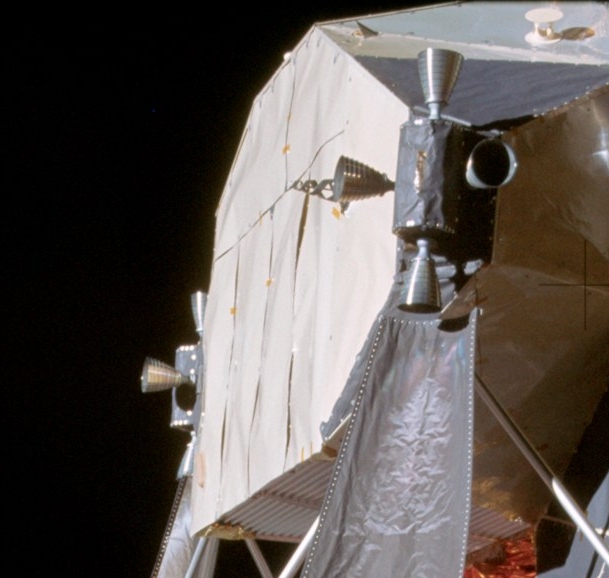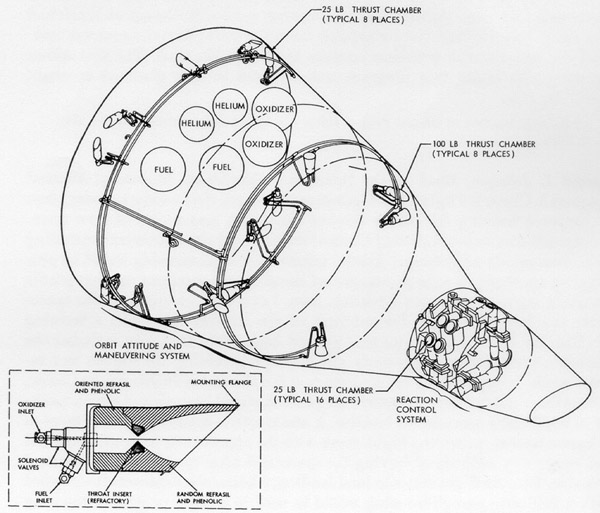Reaction control system on:
[Wikipedia]
[Google]
[Amazon]
 A reaction control system (RCS) is a spacecraft system that uses thrusters to provide
A reaction control system (RCS) is a spacecraft system that uses thrusters to provide
 The Mercury space capsule and
The Mercury space capsule and
 The suborbital
The suborbital
NASA.gov
{{Webarchive, url=https://web.archive.org/web/20090524033739/http://science.ksc.nasa.gov/shuttle/technology/sts-newsref/sts-rcs.html , date=2009-05-24 Spacecraft attitude control Spacecraft design Spacecraft propulsion
 A reaction control system (RCS) is a spacecraft system that uses thrusters to provide
A reaction control system (RCS) is a spacecraft system that uses thrusters to provide attitude control
Attitude control is the process of controlling the orientation of an aerospace vehicle with respect to an inertial frame of reference or another entity such as the celestial sphere, certain fields, and nearby objects, etc.
Controlling vehicle ...
and translation. Alternatively, reaction wheels
A reaction wheel (RW) is used primarily by spacecraft for three-axis attitude control, and does not require rockets or external applicators of torque. They provide a high pointing accuracy, and are particularly useful when the spacecraft must be ...
are used for attitude control. Use of diverted engine thrust to provide stable attitude control of a short-or-vertical takeoff and landing aircraft below conventional winged flight speeds, such as with the Harrier "jump jet", may also be referred to as a reaction control system.
Reaction control systems are capable of providing small amounts of thrust in any desired direction or combination of directions. An RCS is also capable of providing torque to allow control of rotation ( roll, pitch, and yaw).
Reaction control systems often use combinations of large and small ( vernier) thrusters, to allow different levels of response.
Uses
Spacecraft reaction control systems are used for: *attitude control
Attitude control is the process of controlling the orientation of an aerospace vehicle with respect to an inertial frame of reference or another entity such as the celestial sphere, certain fields, and nearby objects, etc.
Controlling vehicle ...
during different stages of a mission;
* station keeping in orbit;
* close maneuvering during docking procedures;
* control of orientation, or "pointing the nose" of the craft;
* a backup means of deorbiting;
* ullage motors to prime the fuel system for a main engine burn.
Because spacecraft only contain a finite amount of fuel and there is little chance to refill them, alternative reaction control systems have been developed so that fuel can be conserved. For stationkeeping, some spacecraft (particularly those in geosynchronous orbit) use high-specific impulse
Specific impulse (usually abbreviated ) is a measure of how efficiently a reaction mass engine (a rocket using propellant or a jet engine using fuel) creates thrust. For engines whose reaction mass is only the fuel they carry, specific impulse is ...
engines such as arcjets, ion thruster
An ion thruster, ion drive, or ion engine is a form of electric propulsion used for spacecraft propulsion. It creates thrust by accelerating ions using electricity.
An ion thruster ionizes a neutral gas by extracting some electrons out of ...
s, or Hall effect thrusters. To control orientation, a few spacecraft, including the ISS
The International Space Station (ISS) is the largest modular space station currently in low Earth orbit. It is a multinational collaborative project involving five participating space agencies: NASA (United States), Roscosmos (Russia), JAXA (J ...
, use momentum wheel
A reaction wheel (RW) is used primarily by spacecraft for three-axis attitude control, and does not require rockets or external applicators of torque. They provide a high pointing accuracy, and are particularly useful when the spacecraft must be ...
s which spin to control rotational rates on the vehicle.
Location of thrusters on spacecraft
 The Mercury space capsule and
The Mercury space capsule and Gemini
Gemini may refer to:
Space
* Gemini (constellation), one of the constellations of the zodiac
** Gemini in Chinese astronomy
* Project Gemini, the second U.S. crewed spaceflight program
* Gemini Observatory, consisting of telescopes in the Norther ...
reentry module both used groupings of nozzles to provide attitude control
Attitude control is the process of controlling the orientation of an aerospace vehicle with respect to an inertial frame of reference or another entity such as the celestial sphere, certain fields, and nearby objects, etc.
Controlling vehicle ...
. The thrusters were located off their center of mass, thus providing a torque to rotate the capsule. The Gemini capsule was also capable of adjusting its reentry course by rolling, which directed its off-center lifting force. The Mercury thrusters used a hydrogen peroxide monopropellant which turned to steam when forced through a tungsten screen, and the Gemini thrusters used hypergolic mono-methyl hydrazine fuel oxidized with nitrogen tetroxide
Dinitrogen tetroxide, commonly referred to as nitrogen tetroxide (NTO), and occasionally (usually among ex-USSR/Russia rocket engineers) as amyl, is the chemical compound N2O4. It is a useful reagent in chemical synthesis. It forms an equilibrium ...
.
The Gemini spacecraft was also equipped with a hypergolic Orbit Attitude and Maneuvering System, which made it the first crewed spacecraft with translation as well as rotation capability. In-orbit attitude control was achieved by firing pairs of eight thrusters located around the circumference of its adapter module at the extreme aft end. Lateral translation control was provided by four thrusters around the circumference at the forward end of the adaptor module (close to the spacecraft's center of mass). Two forward-pointing thrusters at the same location, provided aft translation, and two thrusters located in the aft end of the adapter module provided forward thrust, which could be used to change the craft's orbit. The Gemini reentry module also had a separate Reentry Control System of sixteen thrusters located at the base of its nose, to provide rotational control during reentry.
The Apollo Command Module
The Apollo command and service module (CSM) was one of two principal components of the United States Apollo spacecraft, used for the Apollo program, which landed astronauts on the Moon between 1969 and 1972. The CSM functioned as a mother shi ...
had a set of twelve hypergolic thrusters for attitude control, and directional reentry control similar to Gemini.
The Apollo Service Module
A service module (also known as an equipment module or instrument compartment) is a component of a crewed space capsule containing a variety of support systems used for spacecraft operations. Usually located in the uninhabited area of the spacec ...
and Lunar Module each had a set of sixteen R-4D hypergolic thrusters, grouped into external clusters of four, to provide both translation and attitude control. The clusters were located near the craft's average centers of mass, and were fired in pairs in opposite directions for attitude control.
A pair of translation thrusters are located at the rear of the Soyuz spacecraft; the counter-acting thrusters are similarly paired in the middle of the spacecraft (near the center of mass) pointing outwards and forward. These act in pairs to prevent the spacecraft from rotating. The thrusters for the lateral directions are mounted close to the center of mass of the spacecraft, in pairs as well.
Location of thrusters on spaceplanes
 The suborbital
The suborbital X-15
The North American X-15 is a hypersonic rocket-powered aircraft. It was operated by the United States Air Force and the National Aeronautics and Space Administration as part of the X-plane series of experimental aircraft. The X-15 set spee ...
and a companion training aero-spacecraft, the NF-104 AST, both intended to travel to an altitude that rendered their aerodynamic control surfaces unusable, established a convention for locations for thrusters on winged vehicles not intended to dock in space; that is, those that only have attitude control thrusters. Those for pitch and yaw are located in the nose, forward of the cockpit, and replace a standard radar system. Those for roll are located at the wingtips. The X-20, which would have gone into orbit, continued this pattern.
Unlike these, the Space Shuttle Orbiter
The Space Shuttle orbiter is the spaceplane component of the Space Shuttle, a partially reusable orbital spacecraft system that was part of the discontinued Space Shuttle program. Operated from 1977 to 2011 by NASA, the U.S. space agency, thi ...
had many more thrusters, which were required to control vehicle attitude in both orbital flight and during the early part of atmospheric entry, as well as carry out rendezvous and docking maneuvers in orbit. Shuttle thrusters were grouped in the nose of the vehicle and on each of the two aft Orbital Maneuvering System
In spaceflight, an orbital maneuver (otherwise known as a burn) is the use of propulsion systems to change the orbit of a spacecraft.
For spacecraft far from Earth (for example those in orbits around the Sun) an orbital maneuver is called a ' ...
pods. No nozzles interrupted the heat shield on the underside of the craft; instead, the nose RCS nozzles which control positive pitch were mounted on the side of the vehicle, and were canted downward. The downward-facing negative pitch thrusters were located in the OMS pods mounted in the tail/afterbody.
International Space Station systems
TheInternational Space Station
The International Space Station (ISS) is the largest modular space station currently in low Earth orbit. It is a multinational collaborative project involving five participating space agencies: NASA (United States), Roscosmos (Russia), JAXA ( ...
uses electrically powered control moment gyroscopes (CMG) for primary attitude control, with RCS thruster systems as backup and augmentation systems.http://forum.nasaspaceflight.com/index.php?action=dlattach;topic=34777.0;attach=586775
References
External links
NASA.gov
{{Webarchive, url=https://web.archive.org/web/20090524033739/http://science.ksc.nasa.gov/shuttle/technology/sts-newsref/sts-rcs.html , date=2009-05-24 Spacecraft attitude control Spacecraft design Spacecraft propulsion